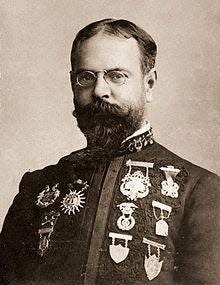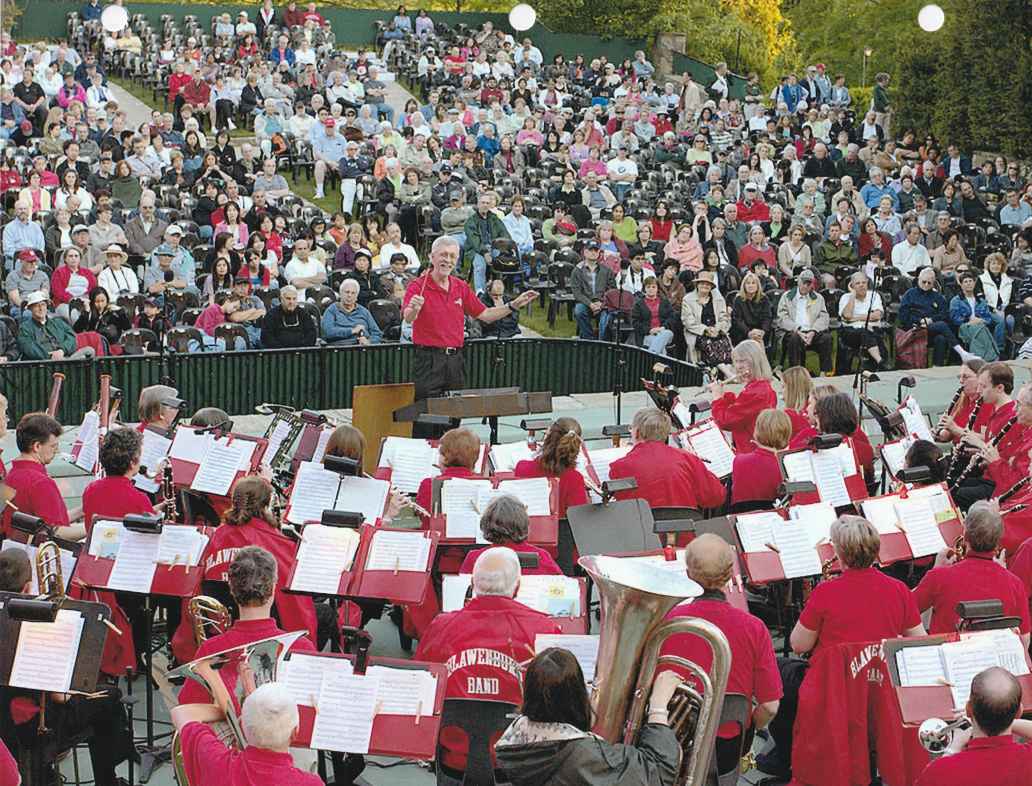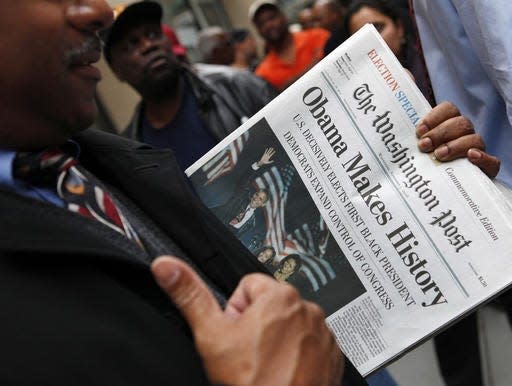This Sousa march is one of the most famous, but did you know its connection to newspapers?
Newspapers, we all agree, are not what they were. The thing we don't agree on is why.
Is it the internet? Or the decline in reading?
Is it because reporters are biased? Or because reporters are so afraid of seeming biased that they waffle? Is it because media conglomerates are so obsessed with the bottom line that they run newspapers into the ground?
All of these points have merit. But there's one additional problem that, hitherto, has received little attention.
Most papers, these days, don't have a march.
Once, they did. Once, a march — that is, a parade tune to be played by a brass band — was as cherished a part of the journalistic tradition as the Sunday supplement, or the newsboy who threw the paper into the puddle.
"Think of any newspaper, they had their own march," said Dr. Jerry Rife, professor emeritus at Rider University, and for 39 years conductor and musical director of Somerset County's Blawenburg Band, established in 1890.
Name that tune

Matters of Fact | A column about our lives in the age of media
You know at least one of these marches — even if you don't know it by name.
"The Washington Post March" (1889) is, second to "Stars and Stripes Forever," the most popular march in the world — certainly among the classics written by "march king" John Philip Sousa. The tune, if not the title, is instantly recognizable. But perhaps you never really thought about the connection between the Sousa's piece and Jeff Bezos' paper.
There might have been no Washington Post in 1972 to expose the Watergate scandal — no Washington Post today — if Sousa's hit tune hadn't put the limping paper, just 12 years old at the time, into the black.

"This was a fledgling newspaper," Rife said. "It was failing. It was not doing well. This helped them a great deal."
It helped them so much, in fact, that other newspapers took the baton and ran with it. There was a "Chicago Tribune March," a "Baltimore Sun March," a "Denver Post March," an "Atlanta Constitution March," a "Hartford Post March," a "Kansas City Star March," a "Detroit Free Press March," a "New York Journal March," a "Chicago Daily News March," a "News-Sentinel March," a "Toledo Blade March," a "Advocate Messenger March," a "Courier-Journal March."
So many newspaper marches, in fact, that one musicologist, George C. Foreman, has made them his special study. He's compiled a whole CD of them.
No less a star than Arthur Pryor — the nation's second most popular bandleader after Sousa, and Asbury Park's biggest musical name until Springsteen — wrote a St. Louis "Post Dispatch March." More than 100 of these newspaper marches were written, most in the early part of the 20th century. They were played at bandshell concerts, promotional events. Just about every paper had one. With one notable exception. The Gray Lady sat this one out.
"Sadly, there is no march — yet — for the New York Times," Rife said.
March madness
Why marches?
Why not marches? Newspapers, back then, would go to any lengths to increase circulation. Baby contests, rotogravure sections, Sunday funnies, vice crusades, serials, sex scandals, the occasional hoax — whatever it took. The "circulation wars" of the late 19th and early 20th century were no joke. Anything that could give a paper a competitive edge was fair game. Including a march — then the best-loved form of popular music.
"It was the perfect kind of music to attract any American," said Rife, whose Blawenburg Band is by all accounts the oldest continuously performing community band in New Jersey. "It was stirring. Very patriotic. And it was something you could digest in two and a half minutes."
"The Washington Post March" wasn't even the first of its kind. There had been perhaps a dozen newspaper marches earlier on, Rife said. But this one caught on like no other.
"It's something you could dance to, move to," Rife said. "It's in 6/8 rhythm, which means there are six beats to a measure. So it's very propulsive. People just loved the rhythm of it."
So much so that it changed the national style of dance overnight.

In addition to being great to march to, "The Washington Post" was also a perfect tune for the "two-step" — a dance novelty that was being promoted at an 1889 national convention of dancing masters in Washington D.C. Music and dance promoted each other. Soon people were doing nothing but the two-step — and doing it to "The Washington Post March." "It killed the waltz," Rife said.
Stuntmen
It was all a bonanza, undreamt of, for General Frank Hatton and Beriah Wilkins, the owners of The Washington Post. The March had been gravy, an afterthought. Just a small part of a big circulation stunt — a Hail Mary effort to save their foundering paper.
The main event was an essay contest. "Write an essay on 'What it Means To Be An American." It was open to schoolchildren from grades 2 through 11 in the Washington, D.C., area, and the prize was a solid gold medal — one for each grade.
Some 22,000 applicants sent in essays. But in order to apply, you had to send in your name and address.
"Families had to request an entry blank by mail," Rife said. "This gave the owners of the paper the name and address of 22,000 residents in their immediate area. That's how you increase your readership. Brilliant publicity stunt."
It was quite a contest. Among the 23 judges was no less than Frederick Douglass. Winners got to read their entries aloud, on the Smithsonian grounds, to a crowd of 25,000 — the majority of them children — that included President Benjamin Harrison's private secretary (the president had a scheduling conflict), and Supreme Court associate justice Samuel Freeman Miller, who handed out the medals.
And, oh yes, there was music.
Incidental music
"They asked the director of the U.S. Marine Band if he could write a march for the occasion," Rife said. "John Philip Sousa said he would be glad to do that, and he would call it 'The Washington Post March.' "
It was a sensation. The band had to play it twice. Shortly after, The Washington Post featured Sousa's sheet music on its cover. Sousa's sheet music, meanwhile, featured a picture of The Washington Post on its cover. Whenever you heard the march, you thought of the newspaper. Whenever you saw the newspaper, you hummed the march. It was branding — and cross-marketing — on an epic scale. "The newspaper was appealing to its audience using audiology," Rife said.
"The Washington Post March" was the making of the newspaper, and the making of Sousa. Over the next 10 years, it traveled everywhere. It was heard on piano rolls. It was squawked out of the newfangled gramophones. People played it on zither, on banjo, on mandolin, on piano — two hands, four hands, six hands. Children played it at their music recitals. All two-steps, whatever the actual music, were known as "Washington Posts."
And when Sousa went overseas, all they wanted to hear was "The Washington Post March." In Germany, the land of the waltz, people yelled out, "Play der Washington Poost!" "It turned out that the 'Washington Post' was requested as an encore to every piece on the program," Rife said.
Paying the piper
And of course, every other newspaper had to have a march. In time, there was even a "National Press Club March," an "Associated Press March," a "White House Correspondents March." There were marches written in honor of individual reporters. "The Town Crier March," a late example written in 1960 by Leonard B. Smith, was a tribute to journalist Mark Beltaire, who had a column called "The Town Crier" in the Detroit Free Press. "That was his favorite journalist," Rife said. "He loved the guy."
To this day, The Washington Post has a John Philip Sousa Community Room, complete with a life-size portrait of the bandleader, in honor of his role in saving the paper.

It's more compensation than Sousa got at the time. For "The Washington Post March," his publisher Harry Coleman paid him a lordly $35.
"Coleman made millions and started three new musical instrument companies with his money," Rife said. "No one knows what Sousa did with his $35."
This article originally appeared on NorthJersey.com: 'The Washington Post' march by John Philip Sousa saved the paper
